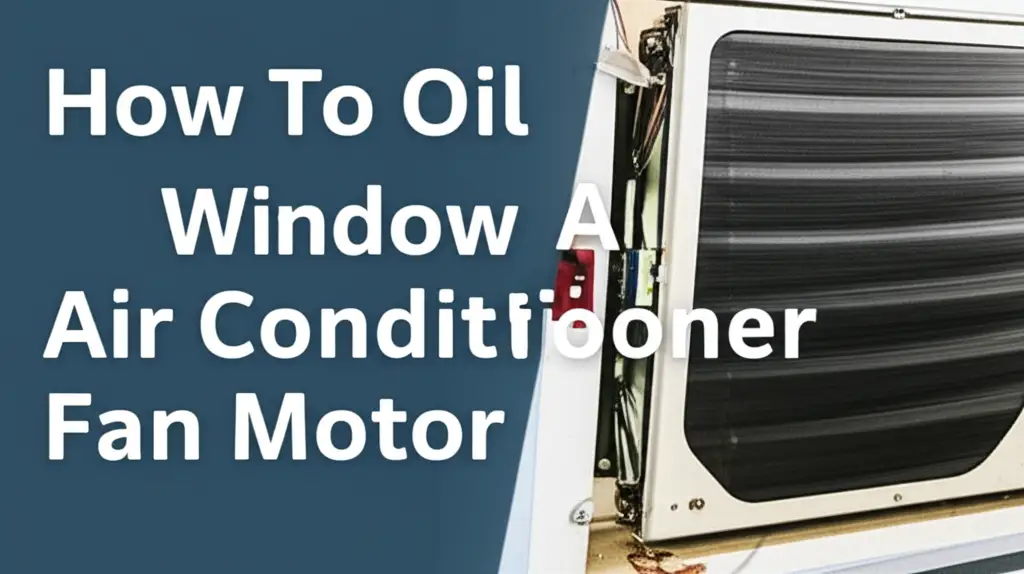· Davia Murnell · Home Appliance Maintenance · 13 min read
How To Oil Window Air Conditioner Fan Motor

Restore Quiet Operation: How To Oil Your Window AC Fan Motor
Is your window air conditioner making a new, irritating noise? A squealing or grinding sound often points to a dry fan motor. This issue impacts your comfort and the unit’s lifespan. Learning how to oil your window air conditioner fan motor can resolve these noises. It also helps your AC run more efficiently.
Oiling your AC motor is a simple maintenance task. It can save you money on repair costs. A well-lubricated motor works better. It also lasts longer. This guide gives you clear steps to complete the task safely. I will walk you through preparation, disassembly, oiling, and reassembly. Get ready to enjoy a quieter, more efficient home.
Takeaway
- Lubricating your window AC fan motor prevents noise.
- The process needs specific tools and safety steps.
- Regular oiling helps extend the life of your AC unit.
To oil a window air conditioner fan motor, first disconnect all power. Remove the unit’s casing to access the motor. Locate small oil ports near the motor shaft or bearings. Apply 3-5 drops of non-detergent 20-30 weight motor oil or electric motor oil into each port. Then, reassemble the unit.
Understanding Your Window AC Fan Motor and Its Needs
Your window air conditioner works hard to keep your home cool. The fan motor is a central part of this operation. It moves air across the coils, distributing cool air into your room. Over time, friction builds up within the motor’s bearings. This friction causes wear. It also creates annoying noises like squealing or grinding.
Motors need oil to reduce this friction. The oil provides a smooth surface for moving parts. Some fan motors have sealed bearings. These motors do not need oiling. They are designed to last without added lubrication. Other motors have small access ports. These ports allow you to add oil. You can provide proper care by identifying your motor type.
Listen to your AC unit carefully. Reduced airflow, strange sounds, or the unit struggling to start are common signs. These indicate that your fan motor might need attention. Sometimes, cleaning alone can help reduce noise. You can learn more about general maintenance by exploring how to clean your air conditioner. Proper lubrication ensures the motor spins freely. This improves air circulation. It also prevents overheating.
The type of oil you use is very important. You should use a non-detergent 20-30 weight motor oil or specific electric motor oil. Household oils like WD-40 are not suitable. They can attract dust. They can also break down quickly. This causes more harm than good. Using the right oil protects your motor. It keeps your AC running smoothly.
Safety First: Essential Precautions Before You Begin
Working with any appliance, especially an air conditioner, requires strict safety measures. Electricity can cause serious harm. My first and most important rule is always to unplug the unit. Do not just turn it off. Pull the plug from the wall outlet completely. This ensures no power reaches the unit.
Set up your workspace carefully. Choose a dry, well-lit area. Make sure you have enough space to work. Keep the area clear of clutter. This prevents trips and falls. It also helps you keep track of small parts.
AC units contain capacitors. These components store an electrical charge. They can deliver a shock even after the unit is unplugged. If you are unsure how to safely discharge a capacitor, do not proceed. It is always better to leave this to a professional. If you decide to continue, use a screwdriver with an insulated handle to discharge the capacitor. Touch the metal shaft of the screwdriver across the two terminals of the capacitor. This will safely drain any stored charge.
Protect yourself with personal protective equipment (PPE). Wear work gloves to protect your hands from sharp edges. Safety glasses guard your eyes from dust or debris. These simple steps make the job much safer for you. Knowing why your window air conditioner is not turning on often starts with checking power and safety. Follow these precautions. They protect you during the repair process.
Gathering Your Tools and Supplies
Having the right tools makes any DIY job easier. It also makes it safer. Before you start, gather all the items you will need. This prevents interruptions once you begin. You will likely need a set of screwdrivers. Both Phillips and flathead types are common for AC units. Pliers can help with stubborn fasteners or wires.
Work gloves are essential for protecting your hands from sharp edges or dirty components. A flashlight or headlamp is also very useful. It helps you see into tight, dark spaces inside the unit. Place a drop cloth or old towels under the AC. This protects your floor from dirt or oil spills.
Cleaning is part of the process. Have a small brush or a handheld vacuum ready. These will help you remove dust and debris from around the motor. For the oiling itself, you need the correct lubricant. Use a specific electric motor oil or a non-detergent 20-30 weight motor oil. Do not use generic household oils like WD-40. They are not designed for continuous lubrication of motor bearings.
An oil can with a thin nozzle or a small dropper allows precise application. It prevents over-oiling. A multimeter is optional. It helps confirm if a capacitor is fully discharged before you touch it. You can learn more about general cleaning steps by checking out how to clean a window air conditioner without removing it. Having these items ready ensures a smooth and effective maintenance session.
Accessing the Fan Motor: Step-by-Step Disassembly
Accessing the fan motor in your window AC unit is the most involved part of this job. It requires careful disassembly. Always start by removing the outer casing. Look for screws around the edges and bottom of the unit. These usually hold the metal or plastic cover in place. Keep track of all screws. Labeling them or placing them in separate containers can help during reassembly.
Once the outer casing is off, you will see the internal components. The fan motor sits between the evaporator and condenser coils. It drives both the indoor blower fan and the outdoor condenser fan. You will need to remove other internal parts to gain full access. This often includes the front grille, air filter, and sometimes the control panel. Be gentle when detaching wires. Take photos of wire connections if you are unsure.
Next, you may need to remove the drain pan. This pan collects condensation. It often sits directly under the evaporator coil. After the pan, you will see the fan blades. The indoor blower fan (squirrel cage) and the outdoor propeller fan attach to the motor shaft. Each fan is usually secured by a set screw. Loosen these screws with an Allen wrench or a small screwdriver. Carefully slide the fan blades off the shaft. Be gentle; they can be fragile.
Navigating Different AC Models
Every AC model is slightly different. Some units are easier to open than others. Some motors are more accessible. You might find online diagrams or service manuals for your specific brand and model. This can be very helpful. Remember to take photos at each step. These photos will guide you when you put everything back together.
Documenting Disassembly
I recommend taking pictures of each step as you disassemble the unit. This visual record is a lifesaver for reassembly. Note where each screw came from. Organize parts in order of removal. This simple habit prevents frustration later. For detailed cleaning of similar components, you can refer to tips on how to clean a blower motor. Proper documentation ensures you put everything back correctly.
Locating and Oiling the Fan Motor Ports
Once you have the fan motor exposed, your next step is to find the oil ports. These ports are tiny holes. They are usually located near the motor shaft. You will find them at both ends of the motor housing, close to the bearings. The bearings are the points where the shaft rotates. Some motors have a small cap covering these holes. You might need to gently pry them open.
Before applying oil, clean the area around the ports. Use a small brush or a cotton swab. Remove any dust, lint, or grime. A clean surface helps the oil enter freely. It also prevents dirt from getting into the motor. This step is important for long-term motor health. Keeping the motor clean helps prevent future issues. You can also use this opportunity to look for other debris. Sometimes, dirt buildup can cause problems. If you find mold during this process, information on how to clean mold from your window air conditioner can be very useful.
Now, apply the oil. Use your small oil can or dropper. Place 3 to 5 drops of the recommended oil into each port. Do this slowly. Allow time for the oil to seep in. Do not over-oil. Too much oil can attract more dust. It can also cause oil to leak out. After applying the oil, manually rotate the motor shaft a few times. This helps distribute the oil evenly. It ensures the lubricant reaches all parts of the bearings.
What if there are no oil ports?
Some modern fan motors have sealed bearings. These motors do not have oil ports. They are designed to be maintenance-free. If your motor lacks oil ports, do not try to force oil into it. Doing so can cause damage. A sealed motor that is making noise likely needs replacement. Oiling will not fix it. In such cases, professional assessment is the best next step. Trying to lubricate a sealed motor can void its warranty.
Reassembly and Testing Your Window AC Unit
After oiling the fan motor, it is time to put your window AC unit back together. This process is the reverse of disassembly. Start by carefully reinstalling the fan blades onto the motor shaft. Make sure they are correctly oriented. Tighten the set screws firmly. Ensure the blades are secure. Wobbly blades can cause vibration and noise.
Next, replace the internal components. This includes the drain pan, control panel, and any other parts you removed. Connect all wires you detached. Use the photos you took during disassembly as your guide. Make sure every connection is solid. Loose wires can cause power issues or unit malfunction.
Finally, secure the outer casing of the unit. Replace all screws you removed. Double-check that all panels fit snugly. Ensure there are no gaps. Gaps can reduce cooling efficiency. Once the unit is fully reassembled, place it back in its window or on its stand.
Plug in the power cord. Turn on your air conditioner. Listen carefully for any unusual noises. The fan should now run quietly. Check the airflow. It should be strong and steady. Allow the unit to run for at least 15-30 minutes. This gives the oil time to fully distribute within the motor bearings. If your unit still turns off by itself after this maintenance, it might indicate a different issue. You can find more information about why your window air conditioner turns off by itself to troubleshoot further. A successful oiling job means quiet, efficient cooling.
Routine Maintenance for Optimal AC Performance
Oiling your window AC fan motor is one step in a comprehensive maintenance plan. Regular care helps your unit last longer. It also ensures it runs efficiently. I recommend oiling the fan motor annually. Do this at the start of the cooling season. This proactive approach prevents noise and wear. If your AC runs constantly, you might consider doing it more often.
Beyond oiling, keep the filters clean. Dirty filters restrict airflow. This makes the motor work harder. It also reduces cooling efficiency. Clean or replace filters monthly during heavy use. You should also regularly clean the evaporator and condenser coils. Dust and dirt build up on coils. This prevents proper heat exchange. A coil cleaning spray works well for this task.
Always check for signs of wear. Look for frayed wires or corroded parts. Address small issues before they become big problems. Proactive maintenance offers many benefits. It extends the life of your AC unit. It improves cooling efficiency. It also maintains good indoor air quality.
There are times when professional help is needed. If your AC continues to make noise after oiling, or if you notice other issues, call a technician. Complex electrical problems or refrigerant issues need expert handling. If your unit starts to freeze up, it could be a sign of low refrigerant or airflow problems. Understanding why your window air conditioner keeps freezing up can help you decide when to seek professional assistance. Regular DIY maintenance keeps your AC in good shape. It helps you enjoy a comfortable home all season long.
FAQ Section
Q1: How often should I oil my window AC fan motor?
A1: You should oil your window AC fan motor once a year. Do this at the beginning of the cooling season. If your air conditioner runs very often, consider oiling it more frequently. This routine maintenance helps keep the motor running smoothly.
Q2: What kind of oil should I use for my AC fan motor?
A2: Use a non-detergent 20-30 weight motor oil or specific electric motor oil. These oils are designed for continuous lubrication. Do not use general-purpose oils like WD-40. Such oils can attract dirt and cause more damage over time.
Q3: Can I use WD-40 to oil my AC fan motor?
A3: No, you should not use WD-40 for oiling your AC fan motor. WD-40 is a water displacement spray and rust preventative, not a long-term lubricant. It can break down quickly, attract dust, and actually worsen motor performance over time.
Q4: What if my AC fan motor has no oil ports?
A4: If your AC fan motor has no oil ports, it likely has sealed bearings. These motors do not need oiling. They are designed to operate without additional lubrication. If a sealed motor makes noise, it probably needs replacement.
Q5: Will oiling fix a really loud AC fan motor?
A5: Oiling can fix a loud AC fan motor if the noise comes from dry bearings. If the noise is grinding or squealing, lubrication often helps. However, if the motor has significant wear or other internal damage, oiling may not completely fix it.
Q6: Is it safe to oil my AC fan motor myself?
A6: Yes, oiling your AC fan motor yourself can be safe if you follow all safety precautions. Always unplug the unit first. Be careful around electrical components. If you are unsure at any step, contact a qualified technician for help.
Conclusion
A noisy window air conditioner can be quite disruptive. Learning how to oil your window air conditioner fan motor is a valuable skill. This simple maintenance task often restores quiet operation. It extends the life of your unit. I have walked you through the process, from safe preparation to careful reassembly. You learned about the right tools and the correct type of oil. You also know what to do if your motor has no oil ports.
By taking the time to perform this task, you are investing in your home’s comfort. You are also preventing more costly repairs down the road. Remember, regular maintenance keeps your AC running at its best. If you face challenges or feel unsure at any point, do not hesitate to call a professional. Take action today for a quieter, more efficient cooling experience.





